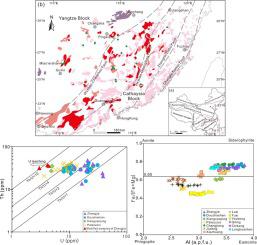当前位置:
X-MOL 学术
›
Ore Geol. Rev.
›
论文详情
Our official English website, www.x-mol.net, welcomes your
feedback! (Note: you will need to create a separate account there.)
Whole-rock and biotite geochemistry of granites from the Miao’ershan batholith, South China: Implications for the sources of granite-hosted uranium ores
Ore Geology Reviews ( IF 3.2 ) Pub Date : 2021-02-01 , DOI: 10.1016/j.oregeorev.2020.103930 Long Zhang , Zhenyu Chen , Fangyue Wang , Taofa Zhou
Ore Geology Reviews ( IF 3.2 ) Pub Date : 2021-02-01 , DOI: 10.1016/j.oregeorev.2020.103930 Long Zhang , Zhenyu Chen , Fangyue Wang , Taofa Zhou

|
Abstract Granite-hosted uranium deposits are the most important types of uranium deposits in South China, but the metal sources of these deposits are still poorly constrained. The Miao’ershan batholith (South China) is a natural laboratory to address this issue, as well as to highlight the use of biotite composition as an indicator for the petrogenesis and uranium fertility of granites. Here, we present whole-rock and biotite geochemical data for U-bearing (Zhangjia and Douzhashan) and barren (Xiangcaoping and Paleozoic) granites of the Miao’ershan batholith. Contents of Li, Be, Mn, Sn, In, Nb, Ta, Ga, W, and U in the studied biotites increase from barren to U-bearing granites, while Mg, Ni, Co, V, and Rb display the opposite trend, which may indicate higher degrees of fractionation of the U-bearing granites. An Fe/(Fe + Mg) ratio of 0.65 in biotite appears to be an efficient threshold to discriminate between U-bearing and barren granites. New ternary discrimination diagrams are introduced, based on Li–V×20–Mn and Sn–Co×5–Nb, respectively, to aid the recognition of the U-bearing and barren granites. The relatively high whole-rock U concentrations (8.0−38.6 ppm) and low whole-rock ratios of Th/U (0.5−3.2) and REE/U (2.1−13.5) of the Zhangjia and Douzhashan granites favored the crystallization of uraninite. The samples experiencing fluid-wallrock interaction from the Zhangjia granite are characterized by low whole-rock U concentrations of 3.0 to 4.2 ppm and high Th/U ratios of 8.2 to 10.1, suggesting that a significant part of the U has been leached out by oxidizing meteoric waters. This confirms that the granite represents the primary source of U at the Zhangjia uranium deposit.
中文翻译:

华南庙儿山岩基花岗岩的全岩和黑云母地球化学:对花岗岩赋存铀矿来源的启示
摘要 花岗岩型铀矿床是华南地区最重要的铀矿床类型,但其金属来源仍然缺乏制约。庙儿山岩基(华南)是解决这一问题的天然实验室,同时也强调了使用黑云母成分作为花岗岩成因和铀肥力的指标。在这里,我们提供了庙儿山基岩的含 U 型(张家和豆渣山)和贫瘠(向草坪和古生界)花岗岩的全岩和黑云母地球化学数据。研究的黑云母中Li、Be、Mn、Sn、In、Nb、Ta、Ga、W、U的含量从贫瘠到含U的花岗岩增加,而Mg、Ni、Co、V和Rb的含量则相反,这可能表明含 U 型花岗岩的分馏程度较高。Fe/(Fe + Mg) 比率为 0。黑云母中的 65 似乎是区分含 U 型花岗岩和贫瘠花岗岩的有效阈值。引入了新的三元鉴别图,分别基于 Li-V×20-Mn 和 Sn-Co×5-Nb,以帮助识别含 U 和贫瘠的花岗岩。张家和豆渣山花岗岩相对较高的全岩U浓度(8.0-38.6 ppm)和较低的Th/U(0.5-3.2)和REE/U(2.1-13.5)的全岩比有利于铀矿的结晶。张家花岗岩经历流体-围岩相互作用的样品的特征是全岩 U 浓度低,为 3.0 至 4.2 ppm,Th/U 比值高,为 8.2 至 10.1,表明大部分 U 已被氧化浸出大气水域。这证实了花岗岩是张家铀矿床中铀的主要来源。
更新日期:2021-02-01
中文翻译:

华南庙儿山岩基花岗岩的全岩和黑云母地球化学:对花岗岩赋存铀矿来源的启示
摘要 花岗岩型铀矿床是华南地区最重要的铀矿床类型,但其金属来源仍然缺乏制约。庙儿山岩基(华南)是解决这一问题的天然实验室,同时也强调了使用黑云母成分作为花岗岩成因和铀肥力的指标。在这里,我们提供了庙儿山基岩的含 U 型(张家和豆渣山)和贫瘠(向草坪和古生界)花岗岩的全岩和黑云母地球化学数据。研究的黑云母中Li、Be、Mn、Sn、In、Nb、Ta、Ga、W、U的含量从贫瘠到含U的花岗岩增加,而Mg、Ni、Co、V和Rb的含量则相反,这可能表明含 U 型花岗岩的分馏程度较高。Fe/(Fe + Mg) 比率为 0。黑云母中的 65 似乎是区分含 U 型花岗岩和贫瘠花岗岩的有效阈值。引入了新的三元鉴别图,分别基于 Li-V×20-Mn 和 Sn-Co×5-Nb,以帮助识别含 U 和贫瘠的花岗岩。张家和豆渣山花岗岩相对较高的全岩U浓度(8.0-38.6 ppm)和较低的Th/U(0.5-3.2)和REE/U(2.1-13.5)的全岩比有利于铀矿的结晶。张家花岗岩经历流体-围岩相互作用的样品的特征是全岩 U 浓度低,为 3.0 至 4.2 ppm,Th/U 比值高,为 8.2 至 10.1,表明大部分 U 已被氧化浸出大气水域。这证实了花岗岩是张家铀矿床中铀的主要来源。











































 京公网安备 11010802027423号
京公网安备 11010802027423号